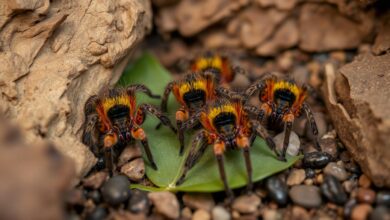How climate and environmental conditions affect tarantula behavior
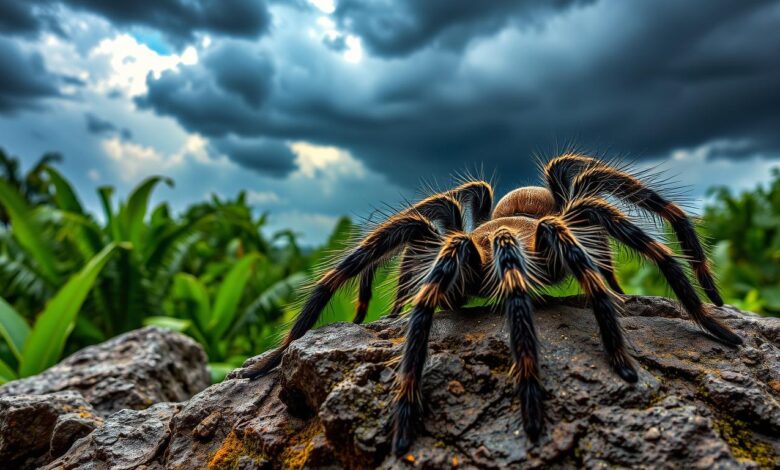
Tarantulas are fascinating arachnids that have evolved unique adaptations to thrive in diverse environments. Their behavior is profoundly shaped by the climate and environmental conditions of their habitats. This article will explore how factors like temperature, humidity, seasonal changes, and abiotic elements influence tarantula behavior. By understanding these complex relationships, we can gain deeper insights into tarantula ecology and conservation.
Tarantulas show remarkable adaptability in their behavior. They respond to temperature and humidity changes and seasonal shifts. Their physiological and behavioral responses to environmental stress reveal their resilience. The influence of microhabitats and climatic factors on their ecological niches provides a fascinating glimpse into the complex web of interactions that sustain tarantula populations.
As we delve deeper into the world of tarantulas, we’ll uncover the vital role that abiotic factors play in shaping their distribution and behavior. From the courtship and mating rituals that unfold in response to environmental cues to the predator-prey dynamics that are intrinsically linked to habitat conditions, this exploration will shed light on the remarkable adaptations that allow tarantulas to thrive in the face of conservation challenges and habitat loss.
Introduction to Tarantula Adaptations
Tarantulas are amazing arachnids with unique adaptations for harsh environments. They have thick exoskeletons and special senses. These traits help them survive and even thrive in tough conditions.
Tarantulas’ Unique Evolutionary Traits
One key adaptation is their tough, armor-like exoskeletons. These protect them from predators and help manage body temperature and water loss. They also have sensitive hairs and organs to detect vibrations and movements.
Biological Mechanisms for Environmental Survival
Inside, tarantulas have systems to deal with environmental demands. Their metabolism helps conserve water and energy, perfect for areas with limited resources. They can also enter dormancy during extreme heat or drought, saving energy until conditions get better.
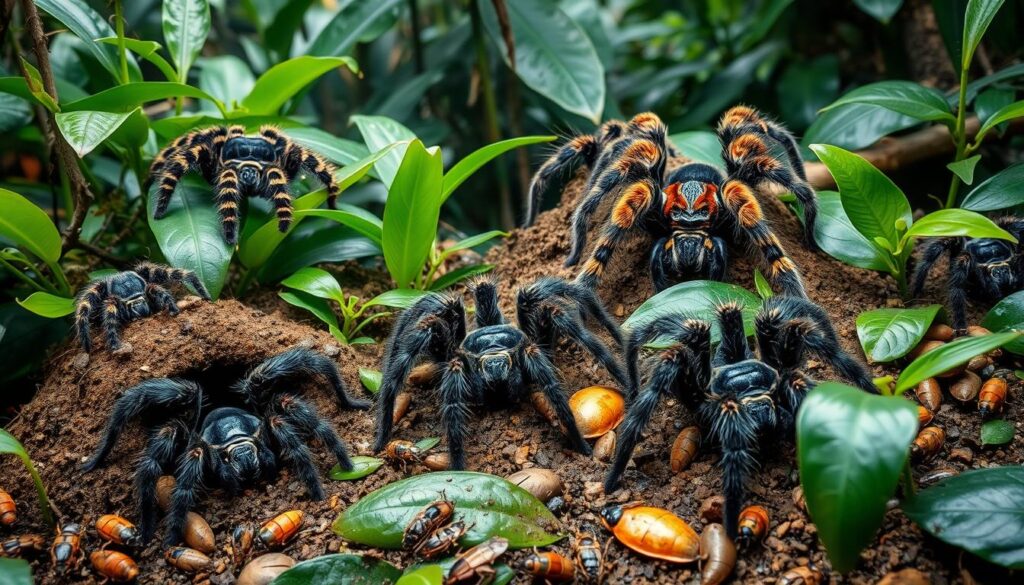
The amazing adaptations of tarantulas show the power of evolution. By studying how they survive in tough habitats, we learn more about tarantula biology. It’s a fascinating world.
Temperature Impact on Tarantula Behavior
Temperature is key for tarantula behavior. They do best in certain temperatures, affecting how active they are and when they eat. Knowing the best temperatures for each tarantula species helps keep them healthy in homes and the wild.
Optimal Temperature Ranges for Activity
Tarantulas need outside heat to stay warm. Most like it between 75°F and 85°F (24°C and 29°C). At these temps, they hunt better, explore more, and grow faster.
They also mate more often. But, if it’s too cold or too hot, they act differently. Too cold, and they move slow or sleep a lot. Too hot, and they get stressed, dry out, and don’t eat or mate as much.
| Temperature Range | Tarantula Behavior |
|---|---|
| 75°F – 85°F (24°C – 29°C) | Optimal activity levels, including hunting, foraging, molting, and mating |
| Below 65°F (18°C) | Reduced activity, sluggish movements, potential hibernation-like states |
| Above 90°F (32°C) | Heat stress, dehydration, decreased feeding and reproductive activities |
Knowing what temperatures tarantulas like helps us keep them happy. This is true for scientists and people who keep them as pets.

Humidity Effects on Tarantula Behavior
Tarantulas are amazing creatures that have learned to live in many different places. They can control their water balance and react to changes in humidity. This is important for their survival, from building webs to shedding their skin.
When it’s dry, tarantulas move more and look for water. But when it’s too wet, they stay hidden to keep from losing too much water.
Building webs is another cool thing tarantulas do. They use their webs to catch food and keep themselves dry. In dry weather, they make their webs stronger. But when it’s humid, they don’t need to work as hard.
Molting is a big deal for tarantulas. It’s when they grow and change their skin. They need the right humidity to do this safely. If it’s not right, they might get sick or even die.
Learning about how humidity affects tarantulas is important. It helps us understand how to protect them and their homes. This knowledge is key for keeping these amazing spiders safe as the world changes.
| Humidity Level | Tarantula Behavior |
|---|---|
| Low Humidity | Increased activity, seeking moisture sources |
| High Humidity | Reduced activity, preference for burrows or retreats |
| Optimal Humidity | Successful web-building and molting |
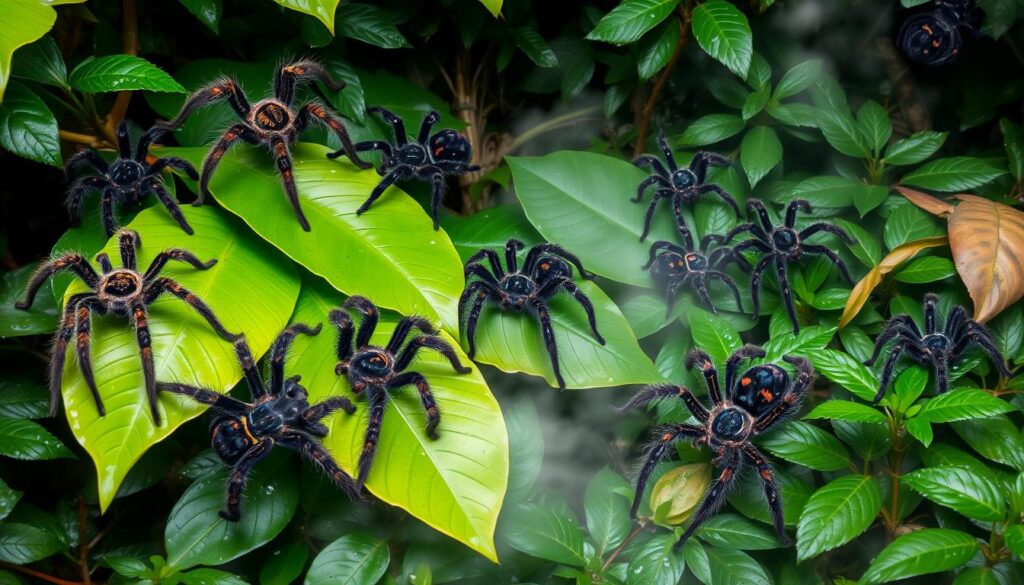
How climate and environmental conditions affect tarantula behavior
Impact of Seasonal Changes on Tarantula Behavior
Tarantulas’ behavior changes with temperature, humidity, and seasonal changes. Rainfall, daylight, and food availability affect their activity, mating, and sleep patterns. Knowing these changes helps protect tarantulas and understand how they react to climate change.
As seasons change, tarantulas adjust their behavior. In warm, wet months, they hunt and mate more. In cold, dark times, they sleep or hibernate to save energy.
Different tarantulas react differently to seasons and weather. Those in dry places notice changes in rain and humidity more. In temperate areas, temperature changes affect them more. Watching these changes helps us understand their strengths and weaknesses.
| Seasonal Factor | Tarantula Behavioral Response |
|---|---|
| Temperature | Increased activity during warmer months, hibernation or torpor during colder periods |
| Precipitation | Enhanced hunting and mating opportunities during rainy seasons, reduced activity during droughts |
| Photoperiod | Adjustments in circadian rhythms and activity patterns based on daylight hours |
| Prey Availability | Tarantulas may alter foraging strategies and hunting behaviors to match seasonal fluctuations in prey populations |
Studying tarantulas and their environments helps protect them. This knowledge helps create better plans for their care and education. It ensures tarantulas can thrive as the climate changes.
 Camouflage and mimicry strategies to avoid predators
Camouflage and mimicry strategies to avoid predators
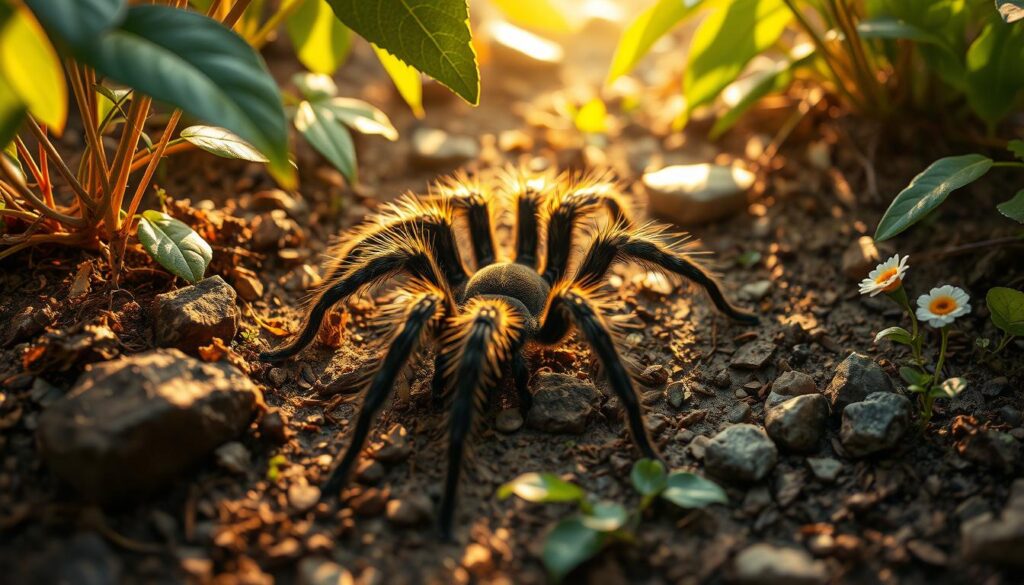
Environmental Stress Responses in Tarantulas
Tarantulas are amazing arachnids with special ways to handle stress. They can deal with extreme temperatures, drought, and changes in their home. These spiders have unique strategies to survive and even thrive in tough conditions.
Physiological Adaptations
Tarantulas can change how they use energy when it’s stressful. They might slow down their body’s work to save energy and water. This helps them get through hard times.
Behavioral Adaptations
Tarantulas also change how they act to deal with stress. They might hunt more when it’s cooler or more humid. This helps them avoid the dangers of too much heat or dryness. Some even dig deeper or hide in small spaces to stay safe.
Studying how tarantulas handle stress can teach us a lot. It shows us how these spiders are strong and how they might be affected by changes in their environment.
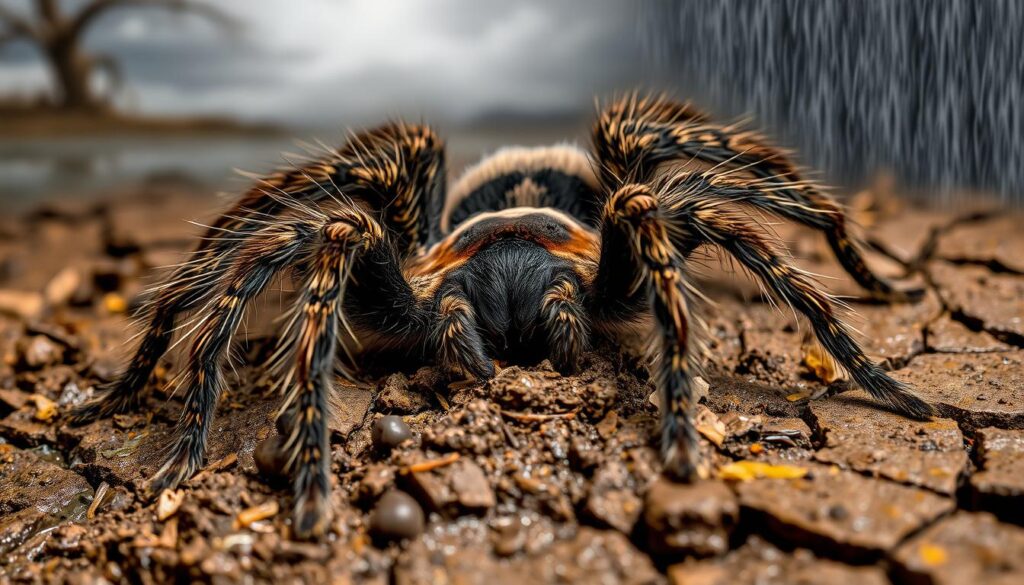
Microhabitat Influences on Tarantula Behavior
Tarantulas are not just sitting around waiting for something to happen. Their actions are deeply connected to their surroundings. Things like the ground they walk on and where they hide can change how they hunt, nest, and defend themselves.
Studies have shown how tarantulas and their homes are linked. For example, a study in Mediterranean areas found many spiders, showing how important their homes are. In cities, ants have learned to live in the heat, showing how their homes affect them.
Looking at cities worldwide, we see how they change the lives of birds and plants. This shows that changes in one area can affect many. Interestingly, an analysis on the spatial patterns of urban biodiversity has pinpointed that wildness and habitat quality are key drivers of these patterns.
For tarantulas, this means their homes matter a lot. Things like the soil, hiding spots, and moisture can all change how they act and survive. Knowing this helps us protect them and their homes, keeping them safe from harm.
| Environmental Factor | Influence on Tarantula Behavior |
|---|---|
| Substrate Type | Tarantulas may prefer certain soil types or substrates for burrowing, hunting, and nesting. |
| Hiding Spots | The presence of crevices, rock formations, or vegetation can provide crucial refuge and shelter for tarantulas. |
| Moisture and Humidity | Tarantulas may exhibit different behaviors in response to varying levels of humidity and moisture in their microhabitat. |
| Temperature Variations | Tarantulas may adjust their activity patterns and hunting strategies based on the specific temperature conditions of their microhabitat. |
Understanding tarantulas better helps us protect their homes. This knowledge can also inform future research directions, as we continue to unravel the intricate relationships between these remarkable arachnids and their microhabitats.
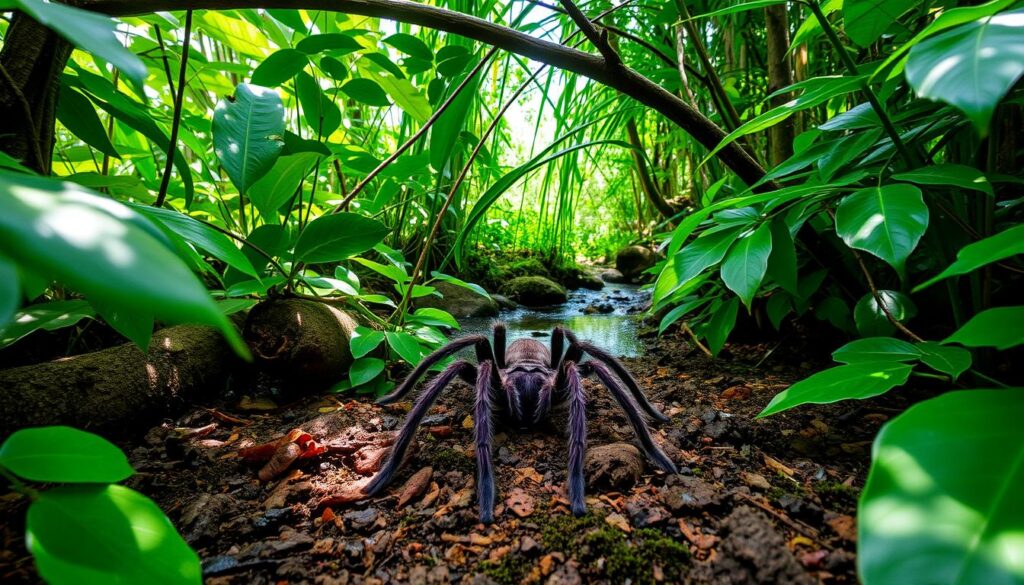
Climatic Factors Shaping Tarantula Ecology
Tarantula ecology is deeply influenced by temperature, humidity, and rainfall patterns. These factors affect their behavior, distribution, and interactions with other species. Understanding these relationships is key to grasping their ecosystem role.
Role of Temperature, Humidity, and Rainfall
Temperature is crucial for tarantulas. It affects their activity, feeding, and breeding. Tarantulas have evolved to thrive in specific, varying by location.
Humidity is also important. It impacts tarantulas’ water balance and breathing. Dry environments are tough, but humid ones are better for many species.
Rainfall affects tarantulas in many ways. It changes prey availability, breeding times, and habitat productivity. Heavy rains or droughts can upset their ecosystems.
| Climatic Factor | Impact on Tarantula Ecology |
|---|---|
| Temperature | Influences activity levels, feeding behavior, and reproductive cycles |
| Humidity | Affects water balance and respiratory functions |
| Rainfall | Impacts prey availability, breeding cycles, and habitat productivity |
Studying climatic factors shaping tarantula ecology offers insights into their environment interactions. This knowledge is vital for conservation and managing tarantula populations globally.
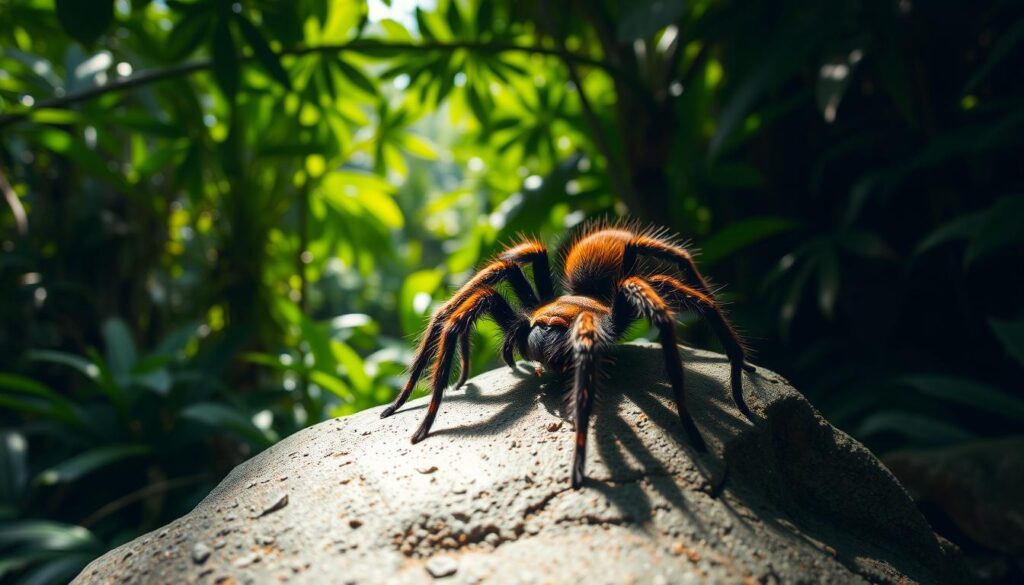
Ecological Niches of Tarantulas
Tarantulas are amazing arachnids found all over the world. They live in places like deserts and rainforests. Each place has its own special conditions that help tarantulas grow and survive.
For example, desert tarantulas save water and handle hot temperatures. Rainforest tarantulas, on the other hand, love the wet and have lots of food. These differences show in how they dig burrows, make webs, and hunt.
Learning about tarantulas’ homes helps us understand their history and how they live. This knowledge is not just interesting. It also helps us protect their homes and keep these amazing creatures alive.

Every tarantula, big or small, has its own special spot in nature. By exploring their homes, we see the beauty and importance of these spiders. They are a key part of our planet’s diversity.
 Aggressive behavior between tarantulas of the same species, especially during mating
Aggressive behavior between tarantulas of the same species, especially during mating
Abiotic Factors and Tarantula Distribution
The abiotic factors of a tarantula’s home, like soil composition and terrain, greatly affect their distribution and behavior. Tarantulas have special ways to live in different soils and landscapes. This shapes how they dig, spin webs, and act. Knowing how these factors influence tarantulas is key for protecting them and their homes.
Impact of Soil Composition and Terrain
Tarantulas have unique ways to survive in various soils, from sandy to clay-rich. The soil’s makeup affects their burrowing and hiding spots. Also, the terrain and topography influence their web-making and hunting.
- Tarantulas in rocky, uneven places often hide in crevices and natural shelters instead of digging big burrows.
- In flat, open spaces, they might wait patiently at their burrow entrances for prey to pass by.
- Those in mountainous or steep areas have better climbing and web-spinning skills to deal with their tough environments.
By grasping the impact of soil composition and terrain on tarantula behavior and spread, experts can help protect these amazing creatures and their homes.

Courtship and Mating Behavior Under Varying Conditions
Tarantula courtship and mating rituals are very complex. They are influenced by many environmental factors. Temperature, humidity, and specific visual and chemical cues can trigger or shape these displays. Studying how tarantulas adapt their mating to different environments helps us understand their evolution and how climate change affects them.
Tarantula mating starts with the male’s courtship dance. He uses his legs and body to attract a mate. The dance’s sequence and intensity change with temperature and humidity. For example, in hot, dry conditions, males dance more to overcome environmental challenges.
Females are more likely to mate under certain conditions. Soil moisture and nesting site availability affect their willingness. Knowing these details helps researchers understand the complex relationship between tarantulas and their environment.
Studying tarantula courtship and mating under different conditions reveals their evolutionary adaptations. As climate change changes our environment, this research is key for conservation. It helps ensure tarantulas survive for a long time.
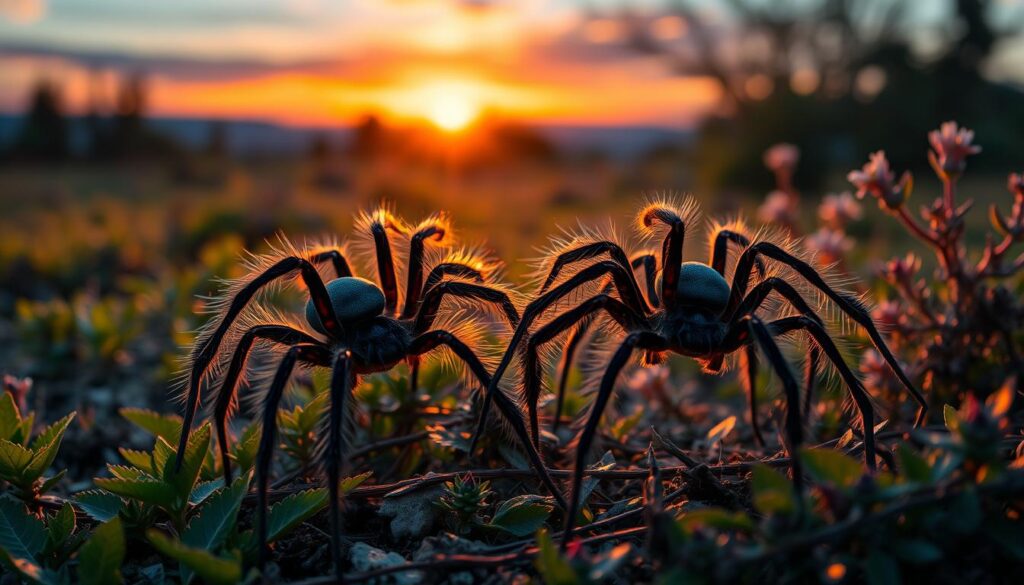
| Environmental Factor | Impact on Tarantula Courtship and Mating |
|---|---|
| Temperature | Influences the intensity and duration of male courtship displays, as well as female receptivity to mating attempts. |
| Humidity | Affects the chemosensory cues used by tarantulas during courtship, as well as the energy expenditure required for mating rituals. |
| Soil Moisture | Impacts the availability of suitable nesting sites for female tarantulas, which can influence their willingness to mate. |
Predator-Prey Dynamics in Different Environments
Tarantulas are key players in their ecosystems as both predators and prey. Their hunting ways and prey availability change with their environment. Knowing how temperature, humidity, and vegetation cover affect tarantulas is vital for keeping their ecosystems balanced.
Tarantula Hunting Strategies and Prey Availability
Tarantulas use different hunting tactics based on their environment. In dry areas, they wait for prey to come close. In green, wet places, they hunt more actively, chasing down their prey.
The amount of prey for tarantulas changes with the environment. In wetter places, there’s more food like insects and small animals for tarantulas to eat. But in dry areas, finding food is harder, leading to more competition and hunting.
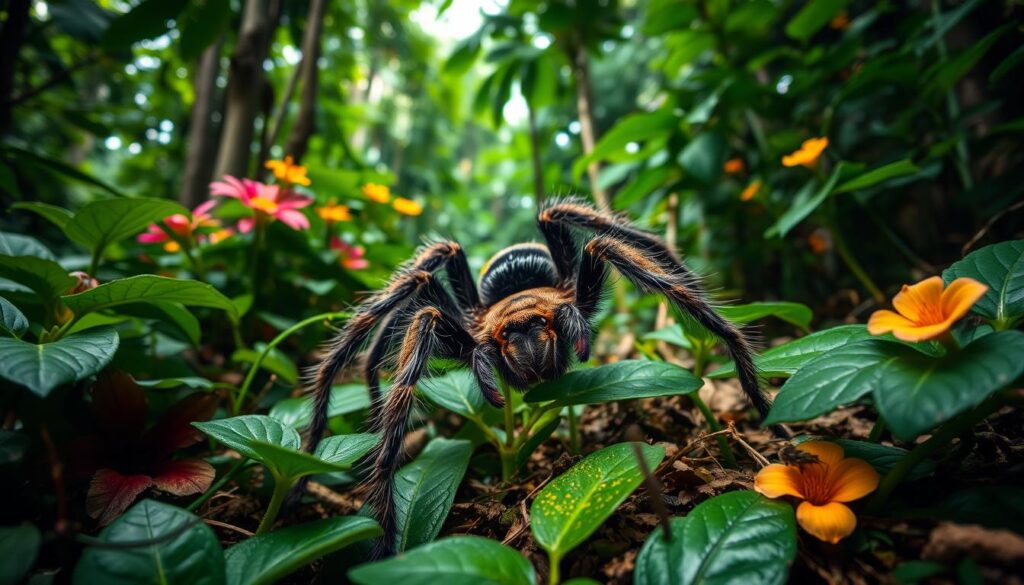
Learning about predator-prey dynamics in different tarantula environments and tarantula hunting strategies and prey availability helps us understand these arachnids better. This knowledge is key for protecting tarantulas and their habitats as the environment changes.
Conservation Challenges and Habitat Loss
Tarantulas face many challenges, mainly due to climate change and habitat loss. Their habitats are getting smaller or destroyed, making it hard for them to survive. We need to understand how they react to these changes and find ways to protect their homes.
Habitat loss is a big threat to tarantulas. Deforestation, urban growth, and farming have taken away their homes. This not only reduces their space but also messes up their food and shelter needs.
Climate change is also a big problem for tarantulas. Rising temperatures and changing weather patterns make it hard for them to adapt. Some may not be able to handle the heat or humidity changes, leading to fewer tarantulas.
| Conservation Challenges | Habitat Loss Factors |
|---|---|
| Climate change | Deforestation |
| Habitat fragmentation | Urbanization |
| Invasive species | Agricultural expansion |
| Illegal pet trade | Infrastructure development |
We need a plan that includes science, restoring habitats, and good laws. Scientists should keep studying how tarantulas react to environmental changes. We also need to restore habitats and make laws stronger to stop illegal trade.
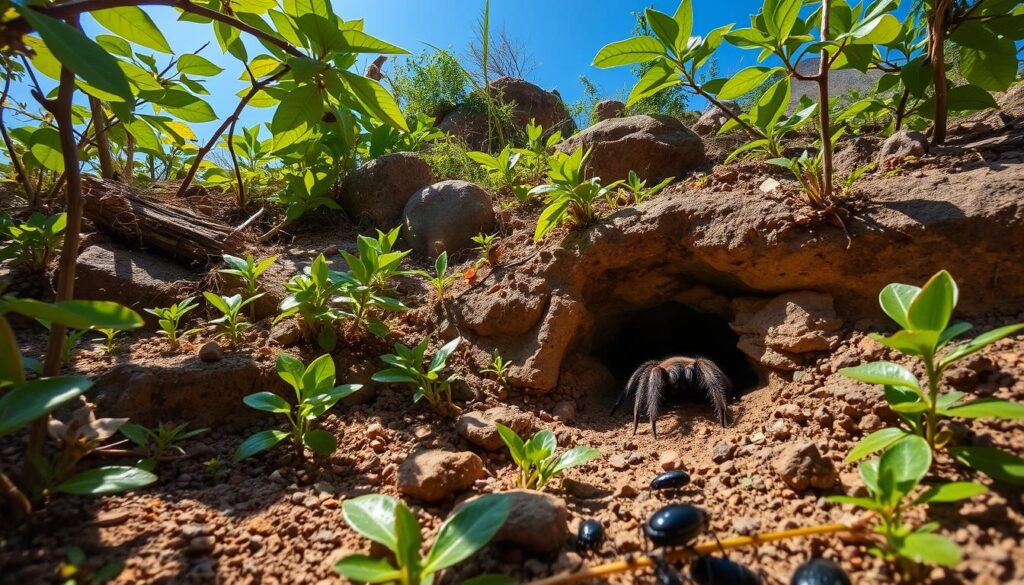
By tackling these issues, we can help tarantulas survive. Scientists, policymakers, and conservation groups must work together. This way, tarantulas can live in their natural homes, adding to our planet’s biodiversity.
Future Research Directions and Implications
The complex relationships between climate, environmental conditions, and tarantula behavior are ripe for further exploration. Future research may look into how climate change affects tarantula populations. It could also examine the role of microhabitats in shaping tarantula ecology. Additionally, it might explore using tarantulas as bioindicators of environmental health.
By deepening your understanding of these fascinating arachnids, you can unlock valuable insights. These insights can inform conservation efforts and enhance captive management practices. They can also shed light on the broader implications of environmental change on wildlife.
As you continue to explore the dynamic interplay between tarantulas and their environment, you will find new avenues for research. These new avenues will expand our knowledge and contribute to the overall protection of these remarkable species. The future holds exciting possibilities for advancing our understanding of tarantula behavior and its intricate connections to the natural world.
 Relationship between molting and behavioral changes in tarantulas
Relationship between molting and behavioral changes in tarantulas

